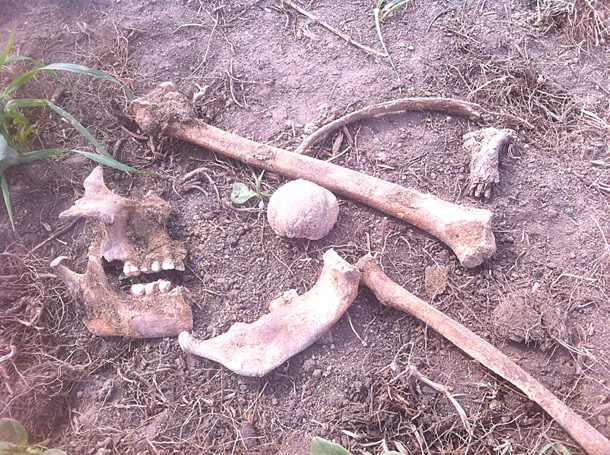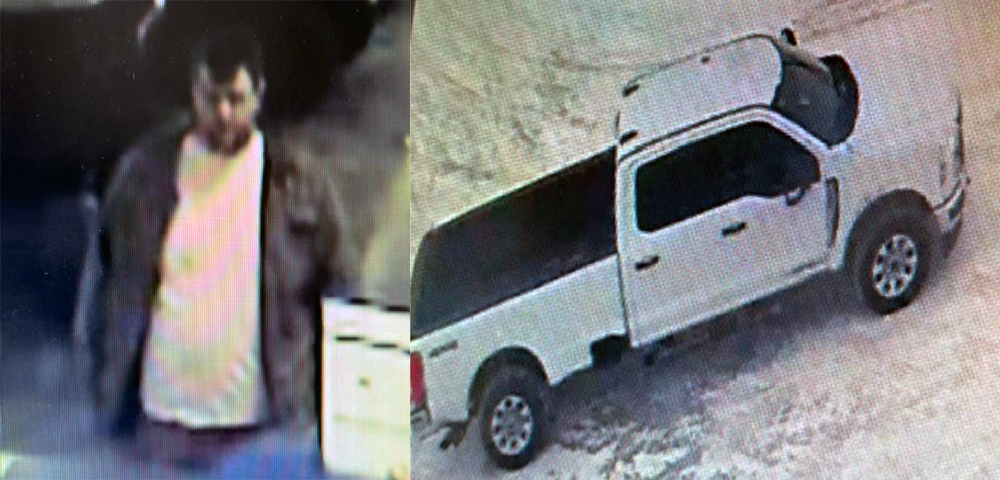Unearthed bones are more than 150 years old

The human bones found on the Rozmahel farm north of Viking on Aug. 26 were those of a young aboriginal man and are estimated to date back as far as 150 years.
The bones of the young man were found by Brian Rozmahel when he was carrying out chores on the farm. He discovered the skull and a number of bones scattered about near a badger mound.
Rozmahel said an archaeology dig is planned at the site before the snow flies. The Edmonton and District Historical Society and the University of Alberta will conduct the dig.
He said forensic anthropologists plan to unearth the entire body of the young man and hopefully can provide information about the origin and identity of the body and the cause and time of death. The body then will be laid to rest at a new site on the Rozmahel farm.
He said a grid system will be established over the site. Each grid unit will be labeled and workers will then determine the location of bones or artifacts within each grid unit to construct a scientific inquiry into what exactly is buried in the area.
Rozmahel said high tech instruments such as ground-penetrating radar equipment will be used to exam the site.
He said if the excavation finds that this young man’s grave is one of many and that an entire burial grounds is located in the field, steps will be taken to determine how many bodies are buried there and how the site will be preserved.
Since the discovery in August, Elders from Maskwacis First Nation have visited the site and performed a pipe ceremony over the grave. Rozmahel said the Elders explained to him that the ceremony was necessary to calm the spirit of the young man as the disruption of the grave site, they believe, made the spirit of the young man uneasy.
First Nations people generally believe a person is created with two spirits.
Upon death, the souls split, with one resting with the buried remains. That’s why physical disturbance of bones is a source of deep anguish.
The First Nations have ceremonies by which that spirit finds its resting place. But when their remains are unearthed, it’s like calling (the spirit) back from a deep sleep. Then something has to be done to make that right again and create stability across time.
“It was just a beautiful ceremony. I was so honoured to be invited to witness and take part. There were only a few of us there as it was a private affair,” he said.
He said the Elders used sweet grass to smudge (the common name given to a powerful cleansing technique from the First Nation tradition) everyone attending the ceremony before offering a number of prayers in Cree and conducting a pipe ceremony where every male is passed the pipe and encouraged to take a puff before returning it to the Pipe Carrier.
“They lit the pipe and passed it among the Elders and then the young Pipe Carrier brought the pipe to the guests. Once we had all drawn on the pipe, a bowl of food consisting of berries and salmon was passed around and we were invited to eat. After we all had a taste of food, the pipe was lit again and passed around. That was followed by a beautiful Cree song.
“It was a sunny, warm fall day and I just went back in time. The ceremony was so touching. I had tears in my eyes. I was just thrilled to be part of it. It has galvanized my appreciation of the past and of all the people who have walked this land and those who will come.”
Rozmahel said when he first found the bones it appeared to him as though a badger had went after gophers and had dug up a grave and unearthed the bones.
After surveying the scene, Rozmahel said he backed away and immediately contacted the local RCMP who arranged for a Forensic Investigation Section and Major Crimes Unit to come to the Viking scene and cordon the area off while a complete investigation was carried out. The RCMP were at the secured location for two nights before releasing the site.
A few of the bones were removed from the site and taken to a lab for further examination.
The tests to date have shown that the bones were those of a young aboriginal male between 17 and 20 years of age. Investigators told Rozmahel that the breaks on the bones were all postmortem meaning that the body was subjected to something that caused the breaks after death.
“I have named this young man Running Badger, the Elders enjoyed that name, and while I do not yet know how he died, further examination of the site may give up more answers,” he said.
No one knows at this point how death came to the young man but Rozmahel has any number of ideas.
“Maybe he fell from a horse, broke his leg and died from that injury. Maybe he was gorged by a buffalo or maybe he just got sick and died. If something like an arrow head is uncovered when the dig is complete, it may mean this young man was a warrior.”
A number of small rings, some beads and buttons were also found in the earth near the bones and Rozmahel thinks these items may hold clues to the identity of the young man.
“The plan is to exhume all of the young man’s remains and lay him to rest in another location on the farm. I have just the place. It is a sunny, beautiful spot,” he said.
“At no time did anyone suggest that I should do this or I should do that. They all totally respected the land and the site.
“The First Nations members were so kind, so respectful not only to the site but to myself and my family. I am so impressed.
“I am so grateful to be able to take part in this spiritual journey, and I am honoured to be asked to watch over the site and protect it from the elements. At no time was I concerned or upset about this find. Everyone should know that this is just a wonderful glimpse into history, and I am just so excited and thrilled to be part of the this amazing event.”
Lorraine Poulsen
Weekly Review









